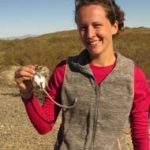EEB Seminar Series – Spring 2019
- All seminars are held on Mondays at 4 pm in HFSB 104 unless otherwise noted.
- Refreshments served before start.
January 16

The ecology and evolution of host-parasite interactions
Presenter: Nicholas Clark, University of Queensland School of Veterinary Science
Hosted by Gary Voelker
January 21
No seminar – Martin Luther King, Jr. holiday
January 22 ***
Faculty Meeting
*** Note location change to WFES 411
January 28

The study of natural history and evolution in the age of genomics
Presenter: Prosanta Chakrabarty, Curator of Ichthylogy, Louisiana State University Museum of Natural Science
Hosted by Kevin Conway
February 4: Graduate Student Presentations

The impact of co-circulating parasites on West Nile virus transmission
Presenter: Andrew Golnar, Hamer Lab, Dept. of Entomology graduate student
Abstract
Interspecific interactions between parasites are known to influence population and community epidemiology. Culex mosquitoes ingest a variety of viral, protozoan, and macro-parasitic organisms that circulate among avian and mammalian hosts, however, the epidemiological consequences of mosquito co-infection on vector-borne transmission remains largely unknown. Based on experimental and published data, we built and parameterized multi-host, multi-vector compartmental models to assess how avian malaria may impact West Nile virus transmission dynamics at population and community scales. Transmission heterogeneity due to changes in vector competence, host competence, survivorship, and mosquito feeding habits were evaluated using stochastic simulations and sensitivity analyses employing a Latin Hypercube sampling design. Results highlight the importance of co-circulating parasites as drivers of disease transmission and provide a framework for ongoing transmission experiments.

Patterns of Parasitism: New Insights into Latitudinal Gradients of Parasite Diversity
Presenter: Whitney Preisser, Light Lab, Wildlife & Fisheriesd Sciences graduate student
Abstract
The latitudinal diversity gradient (LDG), or the trend of higher species richness at lower latitudes, has been well documented in multiple groups of free-living organisms. Investigations of the LDG in parasitic organisms are comparatively scarce. I investigated latitudinal patterns of parasite diversity by conducting two novel investigations of the LDG of helminths (parasitic nematodes, trematodes, and cestodes) of cricetid rodents (Rodentia: Cricetidae). I collected host-parasite records from published surveys and from 300 rodents I sampled across six field sites along a latitudinal gradient in North America. I tested for the presence and direction of a latitudinal pattern of helminth richness at two geographic scales and examined four abiotic factors (mean annual temperature, annual precipitation, annual temperature range, and annual precipitation range) and two biotic variables (host body mass and host diet) as potential correlates of parasite richness. The analyses were performed with and without phylogenetic comparative methods, as necessary. Latitudinal diversity patterns differ among the three helminth taxa but are generally similar across geographic scales. Relationships between helminth richness and the abiotic and biotic variables are also variable between the helminth groups, suggesting taxon-specific responses to abiotic and biotic drivers of diversity patterns. This study supports a complex association between parasite richness and latitude, indicating the importance of including abiotic and biotic factors when trying to understand diversity gradients in parasitic organisms.
February 11

Pathogen community ecology: viral coinfection, coexistence and community composition in grassland ecosystems
Presenter: Eric Seabloom, Dept. of Ecology, Evolution & Behavior, University of Minnesota
Hosted by Bill Rogers and ESSM
February 18

Using common scents: chemosignaling with symbiotic microbes in songbirds
Presenter: Danielle Whitaker, Beacon Center for the Study of Evolution in Action, Michigan State University
Hosted by EEB Graduate Students
February 25

Evolution of anti-bat strategies in moths: Sonar jamming, acoustic deflection and visual lures
Presenter: Akito Y. Kawahara, Curator
Florida Museum of Natural History, McGuire Center for Lepidoptera and Biodiversity, University of Florida
Hosted by Hojun Song
March 4

Sex in the Wild (and especially in New Zealand)
Presenter: Maurine Neiman, Department of Biology, University of Iowa
Hosted by Mariana Mateos
March 11
No seminar – Spring Break
March 18

Finding analogs for ancient ecosystems – merging modern and fossil data
Presenter: Christina Belanger, Department of Geology & Geophysics, Texas A&M University
March 25
Postdoc Presentations
 Arbovirus emergence in the US: a case study on Zika virus
Arbovirus emergence in the US: a case study on Zika virus
Presenter: Estelle Martin, Ph.D., Dept. of Entomology, Hamer Lab
The emergence and re-emergence of mosquito-borne diseases such as Zika, chikungunya and dengue fever remains a global public health challenge that threatens many communities in the continental United States and beyond. The Zika virus invasion into the Americas was declared a public health emergency of international concern due to the rapid spread, unique modes of transmission, and link to birth defects. Local mosquito-borne transmission of Zika virus has now occurred in South Florida and South Texas. To better understand the factors that lead to virus emergence at the Texas-Mexico border we conducted a mosquito surveillance program from September, 2016 to April 2018. The mosquito vector communities in residential areas of South Texas is dominated by Ae. aegypti (62%) the mainvector of Zika virus in the Americas. We report year-round abundance of Aedes aegypti both indoors and outdoors amplifying the risk of human contact with variation in abundance related to socio-economic factors and temperature. Vector competence analysis of these mosquitoes reflect a relatively poor capacity to transmit Zika virus. Additionally, we discuss the role of viral symbiont in the transmission of human pathogens.
 Growing old, yet staying young: the role of telomeres in bats’ exceptional longevity
Growing old, yet staying young: the role of telomeres in bats’ exceptional longevity
Presenter: Nicole Foley, Ph.D., Dept of Genetics, Murphy Lab
Understanding aging is a grand challenge in biology. Exceptionally long-lived animals possess mechanisms that underpin extreme longevity. Telomeres are protective nucleotide repeats on chromosome tips that shorten with cell division, potentially limiting lifespan. Bats are the longest-lived mammals for their size, but it is unknown if their telomeres shorten. Using >60 years of cumulative mark-recapture field data, we show that telomeres shorten with age in Rhinolophus ferrumequinum and Miniopterus schreibersii, but not in the bat-genus with greatest longevity-Myotis. As in humans, telomerase is not expressed in M. myotis blood or fibroblasts. Selection tests on telomere maintenance genes show that ATM and SETX, which repair and prevent DNA damage, potentially mediate telomere dynamics in Myotis bats. 21 telomere maintenance genes are differentially expressed in Myotis, of which 14 are enriched for DNA repair, and 5 for alternative telomere lengthening mechanisms. Here we demonstrate how telomeres, telomerase and DNA repair genes have contributed to the evolution of exceptional longevity in Myotis bats, advancing our understanding healthy aging.
April 1
No seminar, Ecological Integration Symposium (EIS)
April 8
No seminar, Ecological Integration Symposium (EIS)
April 15

Evolutionary divergence and geographic convergence: drivers of evolution and patterns of assembly of one of the world’s most diverse plant families
Presenter: Daniel Spalink, Department of Ecosystem Science & Management, Texas A&M University
Hosted by Hojun Song
April 22

Sex and mitonuclear adaptation in experimental populations of C. elegans
Presenter: Suzanne Estes, Department of Biology, Portland State University
Hosted by Vaishali Katju
April 29

Lizards in the Anthropocene: a paleontological perspective
Presenter: Melissa Kemp, Department of Integrative Biology, University of Texas at Austin
Hosted by David Bapst